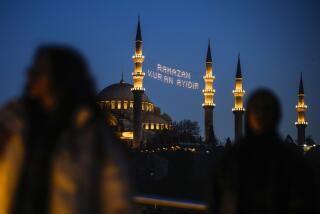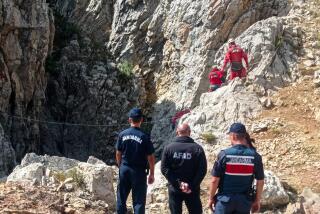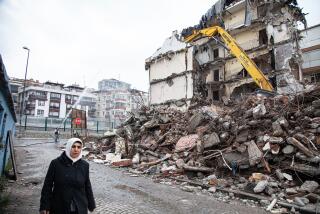THE True Turkey
- Share via
ANKARA, Turkey — Turkey reminds me of the Europe I first knew in the ‘50s when prices were low, the people friendly and discoveries could be made at every turn. And so last July my wife and I embarked on our third visit: a two-week, 1,600-mile journey by car into the heartland, visiting regions relatively unknown to Americans.
Most first-time travelers to Turkey begin in Istanbul and work their way south and then east along the Aegean and Mediterranean coasts. But the wanderer interested in seeing more of the real Turkey must travel inland, as we did, onto the vast Anatolian plateau, 3,000 to 5,000 feet above sea level. There, and in the mountainous realm farther north, we found the country’s heart.
Our previous experiences in Istanbul and on the Aegean Coast had emboldened us. We knew the Turks to be polite and hospitable, ever willing to help strangers in need. We had learned, too, that Turkey has a good road system and relatively little traffic outside the big cities. Rather than sign up for a guided tour, we ventured out on our own. We even made arrangements to rent a house in the village of Uchisar, in the otherworldly province of Cappadocia--dead center in the country--where we would stay for a week before driving north over the Pontic Mountains to the Black Sea.
This time we bypassed Istanbul, flying directly to Ankara, the country’s capital. The city came as a surprise to us. We had read how it lay on the Anatolian Plateau, and we had expected flatness. Instead, we found hills. One of the first things we did was to climb to the top of one, which was crowned by the Hisar, or citadel, a fortress ringed by thick stone walls more than 1,000 years old. From these we had panoramic views of the city . . . or rather of the two cities, the new and the old. In front of us spread 20th century Ankara, white and gleaming, laid out by European planners under the direction of Kemal Ataturk, founder of the modern nation. But when we turned in the other direction, red tile roofs and the pencil-strait minarets of a more traditional Turkey filled our gaze.
The Hisar, we were pleased to discover, contains a village of narrow, meandering streets and ancient houses, some leaning against each other or tipped forward in the exhaustion of age. Despite the presence of several attractive restaurants and a steady stream of European tourists, life goes on pretty much as it did 50 or 100 years ago. We saw women crocheting in the shadow of their doorways, a baker carrying a box of warm bread to a grocery shop, red peppers threaded on lines and hung out to dry like laundry in the sun. And just outside the gate we stumbled upon the old bazaar, with stalls and stands offering everything from herbs and spices to Angora, the silky goat hair from which Ankara took its name.
On the same hill as the bazaar and Hisar stands one of the world’s great museums: the Museum of Anatolian Civilizations, a repository of fascinating artifacts dug from the Turkish earth and encompassing 10,000 years of history. The museum is housed in a warehouse and a former 15th century covered market, converted into sky-lit exhibition spaces. It gave us a sunny overview of the great cultures that have come and gone in the region of Anatolia, from the Hittites, whose empire rivaled that of the Egyptians, to their powerful successors, the Phyrygians and Lydians.
I was intrigued by a recreation of King Midas’ log-built burial chamber, discovered west of Ankara in 1957 under an enormous man-made mound. Curiously, for this Phrygian king who was said to turn everything he touched to gold, not a bit of the precious metal had been buried with him, though there was treasure of another kind: inlaid furniture that miraculously had not crumbled to dust. These extraordinary pieces--which took conservators 15 years to restore--were on view in glass cases that we could walk around, enabling us to examine the workmanship of craftsmen who lived 2,700 years ago.
On another of Ankara’s hills sprawls a monument to Turkey’s recent history, Kemal Ataturk’s mausoleum, the Anitkabir. We taxied there and walked down a wide, vehicle-free avenue lined with grimacing stone lions to a plaza the size of several city blocks. It was flanked by arcaded stone buildings and guarded by members of the armed forces whose marble demeanor made them appear to be made from stone. The largest of the buildings--reached by a broad staircase of 33 steps--contains Ataturk’s tomb, a block of red marble weighing about 40 tons. Dwarfed by the scale of the dark, shadowy chamber, in which gold mosaics glimmered faintly, even we Americans could feel some of the power of this man who wrenched Turkey from its Ottoman past and set it on its path to the future.
*
Refreshed by a couple nights’ good sleep at the Metropole, we were ready to begin our journey. We picked up the Avis rental car we had booked in the States--an air-conditioned 1996 Fiat sedan manufactured under license in Turkey--and drove southeast from Ankara, in the direction of Cappadocia. On the way, we detoured to Hattusas, capital of the Hittite empire, which in 14th century BC included most of Anatolia. Hattusas in its heyday covered 414 mountainous acres. Today little more than sections of its four-mile-long stone walls, several massive gates and foundations of its palace and dozens of temples remain, and it functions more as a ceremonial city than a place for people to live.
We stopped first at Yazilikaya, a shrine deep among boulders and rock outcroppings below the city that was used by Hittite royals for worship. From the appearance of the stocky effigies chiseled in the stone walls, the Hittites must have been a muscular people, well built for war. Three thousand years ago, with a force of 37,000 men and 2,500 war chariots, they had dared take on the 20,000 crack troops of the mighty Egyptian pharaoh Ramses the Great, at Kadesh, Syria, and nearly won the battle.
We then drove up to the top of the city. Buffeted by wind, we could see for miles in all directions. The Storm God, the Hittites’ chief deity, still seemed very much in residence. Cloud shadows skidded across the naked landscape, darkening slopes, valleys and plains in their passage. We ducked into a 236-foot-long tunnel and came out on the other side. The guide we had hired at the entrance to Hattusas explained that the hill through which we had just passed had been artificially created by the Hittites, who faced the slanting side where we now stood with blocks of stone creating a formation rather like a pyramid. We skirted the base and with pounding hearts climbed the long, steep flight of stairs to the uppermost level before retrieving our car and heading for Uchisar.
Our house in Uchisar was one of five renovated by French architect Jacques Avizou who had fallen in love with the hillside village on a visit in 1987 and returned to buy property. It lay in the oldest section, where women in Turkish pantaloons and white head shawls still come to bake bread at the community oven and draw water from the public fountains. The house had been highly recommended by a friend. It consisted of an inner courtyard, a large living room, three bedrooms, a well-equipped kitchen, two and a half baths and an arbored, rooftop terrace that overlooked miles and miles of the Cappadocian countryside. It was furnished throughout with Turkish pieces and carpets.
We were happy to come and go as we pleased, cook our own meals or eat in one or another of Uchisar’s small, cozy restaurants. Wherever we found ourselves during the day, we made sure to return in late afternoon in order to have drinks on the terrace and soak up the view as the sun set. Millions of years ago Cappadocia was buried under the ash spewed by three volcanoes. This compacted into a soft stone called tuff and slowly eroded to form the large cones and other odd forms that fill the landscape today and give it the look of a dried-up seabed. The early inhabitants hacked their houses out of the tuff. The lower portion of ours was cut directly into the stone, as dents left on the walls by blows of a hammer-like adz attested.
Living in stone had several advantages for the ancient Cappadocians, one of them immediately evident: The temperature of our house remained cool and even throughout the day, despite 90-degree temperatures outside. Of far greater advantage to the Cappadocians, though, was the protection the stone gave them. Their land was often subject to invasion, and a cave house high in a cone or cliff, accessed by a ladder that could be raised during an emergency, provided a measure of security. But the inhabitants did much more to ensure their survival. They carved entire underground cities, complete with wells, air shafts and stored food, into which they could retreat when under attack, rolling massive stone wheels across the passages to prevent entry. These subterranean strongholds--36 of which have come to light so far--are often several stories deep and extend in multiple directions.
During the nearly 1,000-year existence of the Byzantine Empire, Cappadocia functioned as an active center of Christianity, and hundreds of cave churches, monasteries and nunneries survive to this day.
*
When our week in Cappadocia ended, we headed north on a six-hour journey across the Anatolian Plateau, past acres of wheat fields toasted a golden brown by the sun, their geometric regularity occasionally interrupted by stands of yellow sunflowers grown for the oil the seeds yield. Twice we thought we were lost and stopped to ask the way. Because the Turks we addressed were unable to speak English, or we Turkish, we had to resort to sign language and maps. Somehow meanings got across, the encounters yielded not only directions but invitations to drink tea, which we had to turn down if we were to reach our destination, the city of Amasya, before nightfall. (Locals had warned us not to drive at night because of farm animals and people roaming about in the dark.)
We paused long enough in a provincial town called Zile to stretch our legs and have lunch. It was near here that Julius Caesar arrived with his army in 47 BC to do battle with the King of Pontus and afterward to utter his famous words, “Veni, vidi, vici” (“I came, I saw, I conquered”). We liked what we saw in Zile: a busy, happy place, filled with the sound of chirping birds and shouting children, alive at its core in a way that many American country towns have ceased to be. No shopping malls have sucked vitality away to the margins. Instead, shops displayed their merchandise in windows and on stands outside, with each street devoted to a different specialty. One, for example, dealt in such indispensable agricultural items as sickles, chains and brass bells for sheep and goats, and we could tell from the ring of hammers that many of these had been made on the premises. Another street featured kitchen equipment, including samovars, used by Turks to boil water for their dark tea.
Surprising ourselves, we arrived in Amasya well before dark. The city, which lies nestled in a narrow river valley between burly limestone mountains, was a center of early revolutionary activity by Ataturk.
Amasya’s architecture captivated us. Lining its riverbank are gracious red-tile-roofed houses. Like those on Florence’s Ponte Vecchio, they project out over the water, supported by thick struts. Behind them rise sheer cliffs in which we could see the cavernous openings of some of the valley’s 18 royal tombs. These, and the long exterior staircases used to reach them, were hacked from the mountains themselves.
From Amasya to the Black Sea is a relatively short distance as the crow flies, but curving mountain roads stretched out the journey as hours of grand scenery unreeled around us. Finally, the water flashed into view. We stopped the car to take it all in. Covered by tea plantations, wheat fields and forests, slopes plunged down to the sea forming coves and half-moon beaches. Why, I wondered, should this dazzling sea have been called Black when, with the sun shining on its surface, it is lapis-lazuli blue, edged along the shore with flows of turquoise and aquamarine running together like paint.
Some day Turkey’s northern coast will attract non-Turks, who will undoubtedly be intrigued by Safranbolu and our next hotel. Called Havuzlu Konak, it had been a rich man’s mansion. In the 19th century the town had prospered as a market for saffron, the spice from which it got its name, and many people used their wealth to erect large homes on the surrounding hillsides. The Turkish Touring and Automobile Club had purchased our building and apparently spared no money converting it into a 25-room hotel.
The center of Safranbolu also showed the benefits of restoration. Much of the old bazaar area had been transformed into a series of cozy shops selling local products ranging from embroidered blouses to decoratively carved wooden canes. Grape vines entwined over the cobbled streets formed a green canopy that filtered the sun and kept the air cool. We were unable to resist the sugar-dusted lokum, or Turkish delight, reputed to be better in Safranbolu than anywhere else in Turkey. We bought two boxes of the pistachio version from a smiling confectioner who insisted we snap his picture in front of his shop, where the sweets were displayed like jewels. In Safranbolu, we moved with the slower, gentler pace of a vanished era.
*
What a contrast the next day offered as we hurtled toward Istanbul on a four-lane superhighway. Arriving at the city’s polluted industrial edge, we stopped a policeman who gave us directions in perfect English, but his words soon dissolved in the welter of streets that opened up before us. Finally, we threw up our hands and told a taxi driver we would pay him if he would lead us to the Avis office.
“You made it,” said a clerk in a congratulatory voice as we came through the door. “We have a saying here in Turkey. If you can find your way in Istanbul, you can find your way to Baghdad.”
Indeed.
(BEGIN TEXT OF INFOBOX / INFOGRAPHIC)
GUIDEBOOK: Talking Turkey
Getting there: Lufthansa flies, with one change of planes, between LAX and Ankara. Advance-purchase, round-trip fares start at $1,135. Various other airlines fly from LAX into a European airport and change to Lufthansa or Turkish Airlines.
Where to stay: For details on how to rent one of the five beautiful houses and two small cottages that French architect Jacques Avizou has renovated and furnished in Uchisar, write to him at Semiramis A.S., 5 Rue du Tendat, 81000 Albi, France, or fax 011-33-5- 63-46-2009. Rates range from $65 to $285 per night, with a three-night-stay minimum. (Book several months in advance.)
Havuzlu Konak (hotel), Celik Gulersoy Cad, Safranbolu; telephone or fax 011-90-372- 725-2883. Rates are $50 to $55 for a double. For reservations, call the hotel during the day when English-speaking reservationists are available.
Tours: Companies offering tours to central Turkey and the Black sea include: Newport International Travel, 2121 San Joaquin Hills Road, Newport Beach, CA 92660, tel. (714) 719-2800; and Cultural Folk Tours International, 9939 Hibert St., Suite 207, San Diego, CA 92131-1031, tel. (800) 935-8875.
For more information: Turkish Tourist Office, 821 United Nations Plaza, New York, NY 10017; tel. (212) 687-2194; fax (212) 599-7568.
More to Read
Sign up for The Wild
We’ll help you find the best places to hike, bike and run, as well as the perfect silent spots for meditation and yoga.
You may occasionally receive promotional content from the Los Angeles Times.






